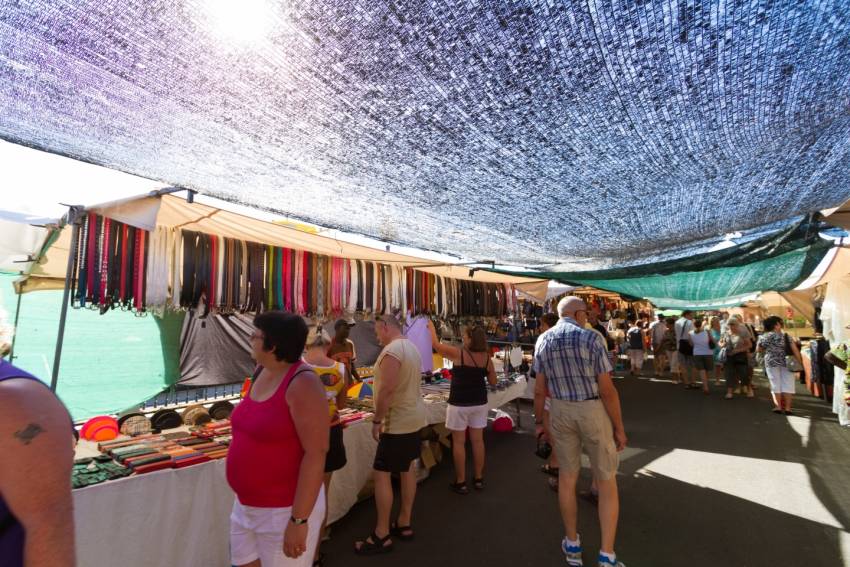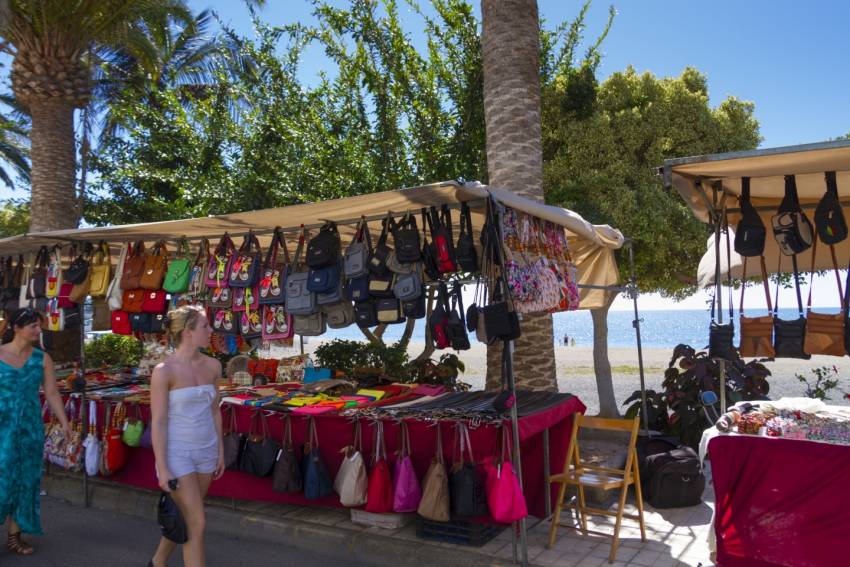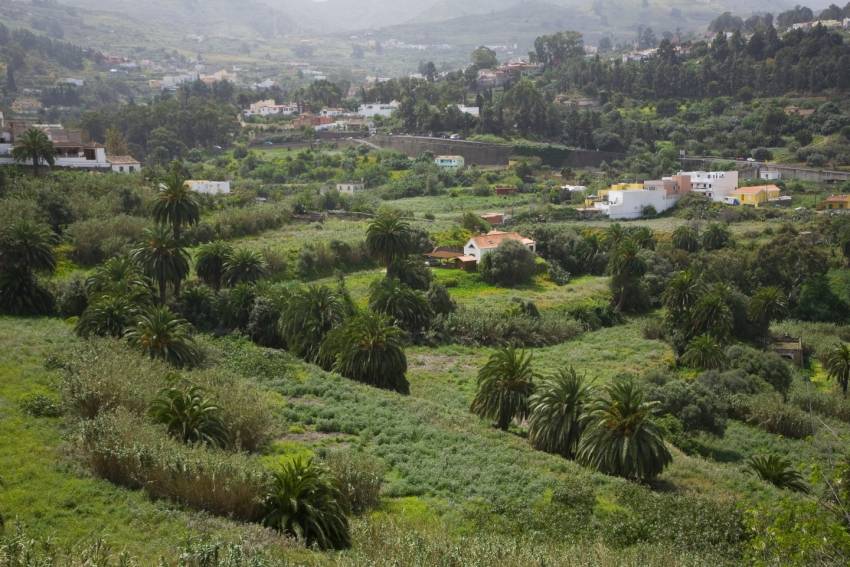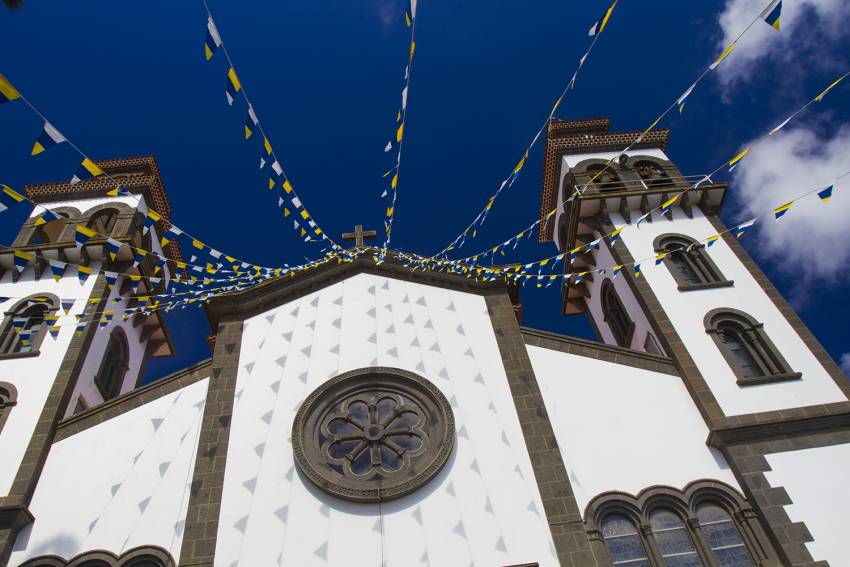Alex Bramwell
Gran Canaria Markets: Workhorse San Mateo
San Mateo market, rather like the town, is a workhorse of a place that put efficiency ahead of aesthetics. Set in a whopping great warehouse it offers a huge range of local produce, has a good wine stall, and is the cheapest of the big north Gran Canaria markets.
Despite it's size San Mateo market gets busy and parking in the town on weekend mornings after about 10.00 am is a nightmare. It's best to get there early for a spot in the car park right by the warehouse. Then you can stick your shopping in the car and head over the main road for lunch in San Mateo's old centre with perhaps a quick salsa dance on the way: There's a band every Sunday by the market.
The San Lorenzo Farmer's Market
The weekend markets at Santa Brigida and San Mateo are so popular these days that there's traffic jams on the road up. Fortunatley there's a Sunday alternative close to Las Palmas that doesn't get the crowds.
San Lozenzo market has about 20 stalls and is a genuine farmer's market with all produce grown locally. It even has a price board at the entrance listing the maximum and minimum prices for the fruit and veg on sale.
One highlight of the San Lorenzo market is the cheese stall right at the entrance. All the cheeses on display are made in the surrounding area and tasting is encouraged. They even cut your cheese with a traditional Canarian knife. Their lightly smoked goat cheese is fantastic and the stall next door does a great flor cheese suitable for veggies.
As well as fresh produce San Lorenzo also has stall selling bread and local cakes as well as aloe vera products, Gran Canarian olive oil and local honey. There's a small cafe in the market square and another in the church square a couple of minutes walk away: It's only got six tables so be prepared to wait for a seat.
Get to San Lorenzo from Las Palmas by car (there is parking right next to the market), taxi or on bus 335. The market runs from 0.900 to 15.00 but quite a few stall sell out well before the end.
Gran Canaria Markets: Puerto Mogan's Massive Friday Market
Puerto Mogán on a Friday is the island's biggest outdoor market with stalls all along through the town and along the harbour wall.
There's hundreds of stalls selling everything from embroidery to fresh fruit and vegetables and you're bound to find something to take home. Combine it with lunch in the marina or a day on the beach and it's a great Gran Canaria day out.
We always recommend getting to the market early to avoid the crowds, especially if you drive and need parking.
A lot of people come by bus, but if you want to get the real holiday feeling why not take one of the glassbottom ferries from Arguineguín or Puerto Rico?
Gran Canaria Info Guide To Arguineguin Market
Arguineguín market is one of the big three in south Gran Canaria along with Mogán and San Fernando and fills the town every Tuesday morning. The stalls are all along the seafront on the cement factory side of town.
Most stall holders at Arguineguín also work the Puerto Mogán and San Fernando markets so there isn't much on sale that you only find at Arguineguín. That said, you can buy everything from silver jewelry to African baskets and it's a great day out. Look out for the smoothie stand at the south end of the market.
Getting to Arguineguin on a Tuesday is tricky if you leave it late as the buses and ferries are often full. Parking is a nightmare so consider hopping in a taxi rather than driving.
Avoid the crowded restaurants on the market side of town by heading back towards the beach for food. There's a string of restaurants facing the beach, including the excellent Taste Mesón.
Gran Canaria Info Style Guide
90% of travel writing is SEO-optimised, cliche-riddled drivel. Or at least it feels that way when you live in Gran Canaria.
When did travel writers stop writing about their experiences and become review monkeys? When did mediocrity become the bar? When did they just give up?
Don't do this
We've had enough of grinding our teeth every time the Google Alert hits our inbox so we've put together this guide for travel writers heading this way.
The essential clichés
All articles must have one of the following in the first paragraph:
- A pun on the island's roundness
- Saying it's like Spain but different
- Mentioning the other, real, Gran Canaria
- Revealing that it's an island of contrasts
- Mentioning the tourist bight, sprawl, plague, etc
You're an explorer
Explorers discover things during adventures. Then they write about them. In the third person. The only way is epic.
- Discover a secret beach
- Explore a hidden valley
- Scale an unknown peak
Had a boring Gran Canaria week short on epic events?
Just cram the entire island into 600 words. Capture its essence as nobody has before.
You know you can do it.
Location, location, whatever
Book a package because it's cheap, stay in a resort because its convenient, do your exploring in a Jeep Safari with a foreign guide.
There's no need for more. It's only a little island and you can see it all from the road.
In fact, why come at all?
Google is your friend.
Unique and amazing vocabulary
Go heavy on the word unique but never provide context: It needs no explanation.
Don't forget the other essentials:
- Fascinating
- Gorgeous
- Wonderful
- Incredible
- Amazing
- Picture-postcard-perfect
All other describing words are redundant.
Use the words traditional and sustainable. It doesn’t matter where: Just get them in.
The word literally can literally be used anywhere.
Words that you don't use in everyday conversation make you sound clever. Like a writer.
- You partake in food
- Have classes imparted to you
- Finds things that are situated in locations
Alliterate alot always
Cuddly, fluffy and mild
English is too short: Puff it out with wills, woulds, shoulds, coulds, cans, be able tos, etc.
The active voice is nasty. It scares people. Passive and cuddly is best.
Never check facts and always hedge in case somebody disagrees.
- Gran Canaria could be the roundest island in the world
- It's said that Gran Canaria has the tastiest bananas.
- I've been told that 80% of ...
It's better to be vague than risk negative comments. Google doesn't like negative comments.
Mince the metaphor, crunch the cliché
In the lively resorts, hotels must perch, pools shimmer, you hit the sun-drenched beaches along with hordes of tourists, cash is splashed, the Yumbo is nudge, nudge, wink,wink (insert funny joke).
Off the beaten track the mountains float in the air, remote villages nestle quaintly, views are panoramic and breathtaking, markets and fiestas are colourful and vibrant and full of friendly locals.
Fataga is picturesque.
Food is always succulent, mouth-watering and delectable. You partake of it in hidden gems that you stumble across..
Locals, what locals?
There are no local people in Gran Canaria except friendly ones dressed up in traditional costume dancing charmingly at authentic local fiestas. Or charismatic ones manning hidden gems. If you must mention a local in any other context, make sure it's a resort barman with a dodgy accent.
Engage with the audience
Once your article is published your work has just started:
- Beg ceaselessly for likes on social media
- Post links repeatedly, frequently
- Join a web ring, blog ring, book club or any other circle of mediocrity
A retweet is a read. A review is a book deal.
You're almost there.
Bonus bleeding edge tip: Change the title of your old stuff and repost it as new. Do this often and without warning.
Got an original, quality piece of writing about Gran Canaria? Sure? Let us know and we'll publish it on Gran Canaria Info with a link back to your personal website.
FAQ
Readers
Who are you?
We're Lex Thoonen and Alex Bramwell and we've run this website about Gran Canaria since 1998. We've both lived on the island for years and spend as much time as possible roaming about finding new things to see and do here.
Can I use your photos on my website?
Please feel free to use them on your personal website and social media pages, but please don't crop out the watermark. If you want to use our images professionally please visit our easy to use picture website PhotosGranCanaria.
I hate you and your opinions about Gran Canaria
We love Gran Canaria and try to be as positive and useful as possible for our audience. If you disagree with us about something please let us know. If we're wrong we'll change it and if we're not we'll explain why. Otherwise, just ignore us.
Professional
My Gran Canaria business isn't featured on the website. How can I change that?
Contact us by email and we'll be in touch. We feature new attractions and businesses every week.
How do I advertise my business on Gran Canaria Info?
We offer a range of advertising options. Please contact us via email and we'l get back to you ASAP.
Can I publish an article or blog post on your website?
Yes, if it's good quality, unpublished, original and mostly about Gran Canaria. No if it's a badly written mass of cliches, old content, or a plug for your business. Please read our style guide and then email us.
Santa Brigida: Gran Canaria Hill Town With A Pretty Market
Santa Brigida town was used by the British as their summer Hill Station when they controlled the coal trade in Las Palmas port in the late 19th and early 20th Century. Nowadays it a quiet residential town with a great weekend market (and a great wine stall) and a couple of excellent restaurants.
Cliff Edge Views In Sleepy Moya
Moya has two claims for fame: Biscuits and a cliff-edge church square with a view of the deep Barranco behind the town. The view is spectacular, the biscuits not so much.
Moya church is a whitewashed Canarian church with stone edging in Neoclassical style. It's pretty but nothing more. However, it stands in a square right on the edge of the deep Barranco de Moya ravine. The view from the edge makes your tummy flip and is well worth a stop.
The town's famous bizcochos de Moya are much less exciting: Just dry biscuits with sugar on top that everyone in Gran Canaria has in the cupboard but nobody ever seems to eat.
Perhaps the real highlight of Moya is the walk around the Los Tilos de Moya laurel forest about five minutes drive from town. This is one of only two patches of laurels that survived the deforestation that followed colonisation and is one of the most biodiverse spots in Europe with dozens of rare Canarian plants. The circular walk takes you up the side of the valley and through the laurels.
Guia: Gran Canaria's Cheese Town
It says a lot about Guía that it's cheese is more famous than the actual town. It's pretty enough but a sleepy kind of place, especially compared with Galder next door.
Santa Maria de Guía's church square and the cobbled streets running off it have their charm. The problem with Guía from a vistor's point of view is that there isn't much do there except for look at it. The Sunday market in the square only has five stalls: It's the place to go to get great Flor de Guia cheese right at source but doesn't sell much else.
Flower cheese
Flor de Guía is a soft, creamy and slightly bitter goat and sheep cheese with a faint odour of socks. It comes in wheels only a few inches thick and tends to sag with age. It's great stuff and is made with cardoon flower sap rather than rennet, making it the only local cheese suitable for veggies.
Cheese festival
Guía perks up during the annual Fiesta de Queso (cheese festival) in April/ May. It's the time to visit with lots of cheese and food stalls and general celebrations of anything cheesy.
If you're in Guía outside fiesta time, head to La Quesera organic cafe for a great selection of local cheese and wine. It's in a 19th Century house and chapel and has an organic garden in its courtyard. The address is Calle Pérez Galdós 27.
God and Garlic Sausage In Teror
Teror is on all the lists of places you have to see in Gran Canaria and is one of the island's prettiest towns with lovely cobbled streets and wooden balconies. That said, the religious angle overwhelms all others in Teror, apart from the pungent sausage.
Gran Canaria Info recommends:
- Default
- Title
- Date
- Random



















